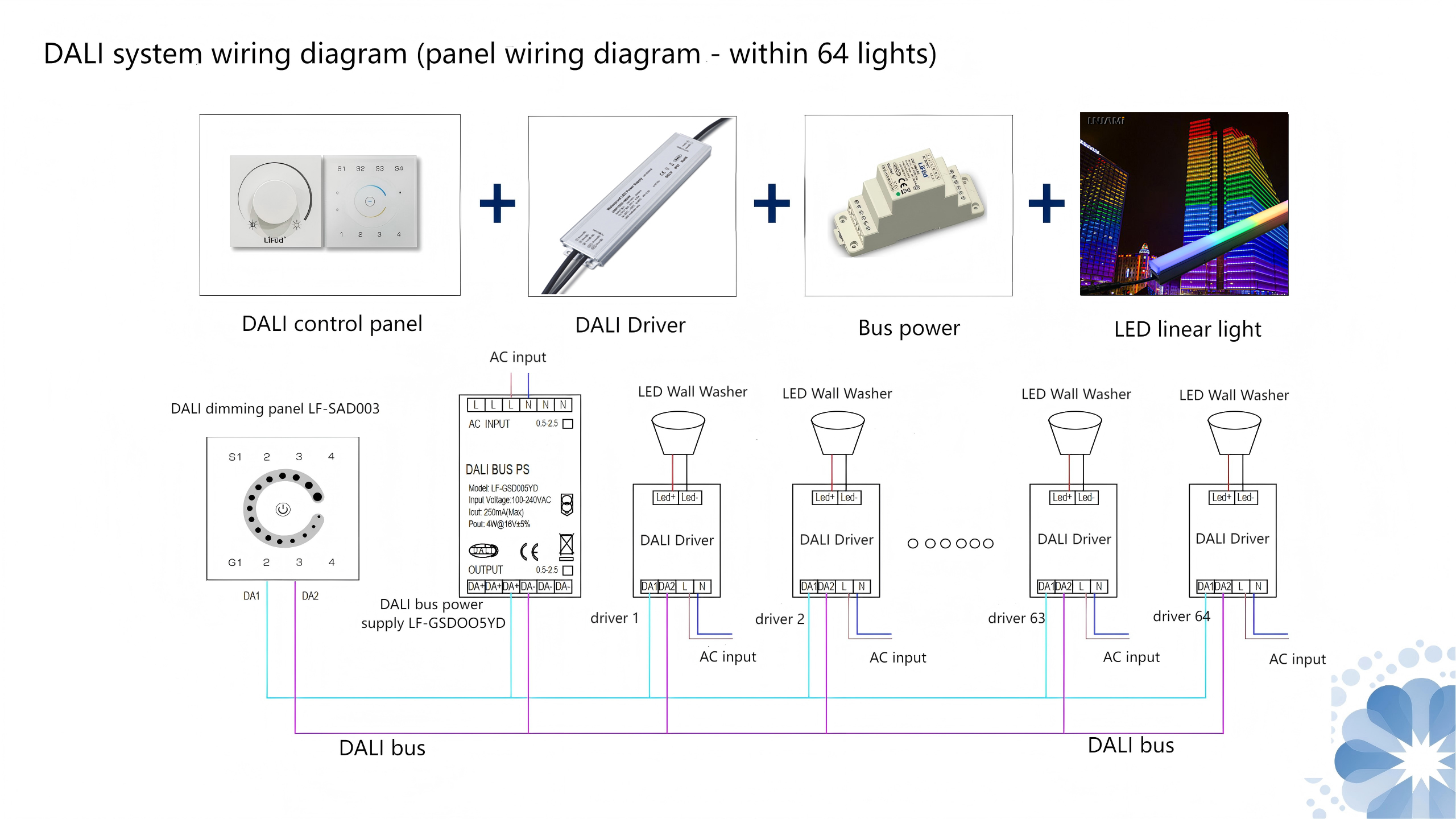LED Circular Tree Light: A Complete Guide to 360° Outdoor Tree Illumination
Under the city’s night sky, trees should not fade into silhouettes — they can become luminous sculptures. The LED circular tree light makes that transformation possible: a ring of engineered LEDs that wraps around the trunk or nestles at the base, casting even 360° uplight that reveals bark texture, sculpts canopy silhouette, and gives landscape elements a new nighttime presence.
This is more than decoration. Circular tree lighting sits at the intersection of landscape architecture, optical engineering, and smart controls: it enhances atmosphere, guides movement, and supports ecological sensitivity through careful spectrum and spill control. In this guide we’ll unpack what LED circular tree lights are, when and why to use them, the key technical specs and mounting strategies, installation and commissioning best practices, and the design and ecological principles that turn ordinary trees into memorable, sustainable nightscape features.
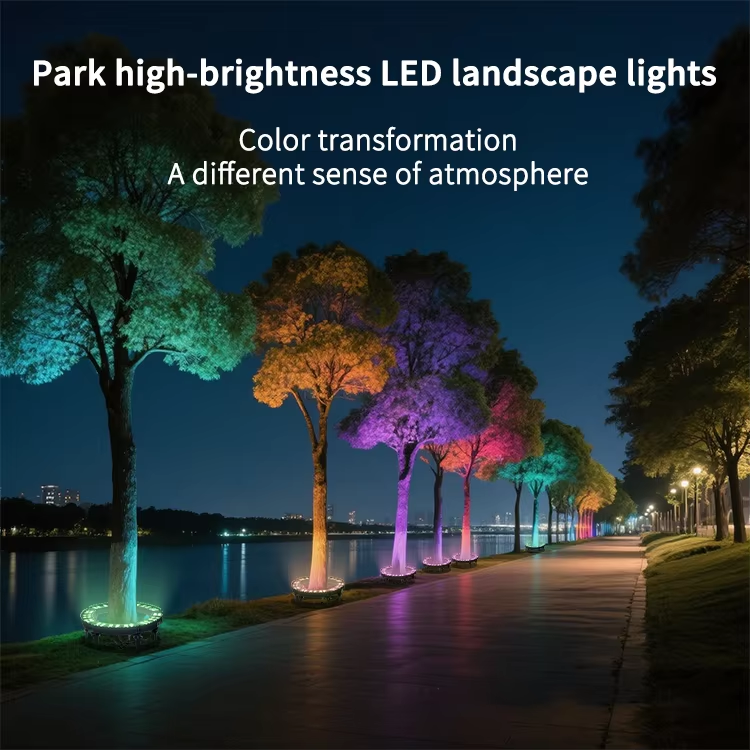
1. What is an LED Circular Tree Light?
Have you ever walked through a park at night and noticed how certain trees seem to glow from within, their trunks and canopies perfectly outlined against the dark? Chances are, you’ve encountered an LED circular tree light—a subtle yet powerful tool that’s revolutionizing landscape lighting.
Unlike traditional floodlights that cast harsh, directional beams and leave uneven shadows, these innovative fixtures are designed as rings or semi-circles that wrap neatly around the base of a tree. They emit uniform upward illumination, highlighting the natural texture of the bark and the elegant spread of the branches in a soft, 360° embrace.
Originally developed for high-end architectural and commercial projects, these lights have now become accessible for residential gardens, public parks, and urban spaces. They blend almost invisibly into the landscape during the day, but as dusk falls, they transform ordinary trees into living works of art—elevating not only the tree itself but the entire ambiance of the space.
Whether used to accentuate a solitary palm in a backyard or to line an entrance avenue of oaks at a luxury resort, LED circular tree lights combine aesthetics, functionality, and technology in a way that feels almost magical. They don’t just light up trees—they bring them to life after dark.
2. Why Choose Outdoor LED Circular Tree Lights for Landscape Lighting?
Beyond their striking visual impact, outdoor LED circular tree lights offer a blend of aesthetic and practical benefits that make them a superior choice for modern landscape design. Their unique ring-shaped design provides wraparound illumination that emphasizes the natural form and texture of trees—turning them into sculptural focal points after dark. Unlike conventional lighting, which often creates glare or uneven brightness, these fixtures produce a soft and balanced glow that feels both dramatic and natural.
From a functional perspective, the advantages are equally compelling. LED technology ensures significant energy savings—often reducing electricity consumption by 60% or more compared to halogen or metal halide alternatives. Their long service life, typically rated between 30,000 to 50,000 hours, means years of reliable operation with minimal maintenance. Built to withstand rain, dust, and temperature fluctuations, high-quality models carry an IP rating of IP65 or higher, making them suitable for everything from private gardens to coastal resorts.
These lights also offer remarkable design flexibility. Available in a range of colour temperatures—from warm white (2700K–3000K) for a cozy mood to cool white (4000K–5000K) for modern clarity—they can be tailored to enhance any setting. For dynamic applications, RGB and RGBW versions allow colour-changing effects that can adapt to seasons, events, or even brand colours.
Whether used to guide visitors along a tree-lined path, enhance safety by illuminating dark corners, or simply create a captivating backdrop for outdoor gatherings, LED circular tree lights deliver both beauty and performance in perfect balance.
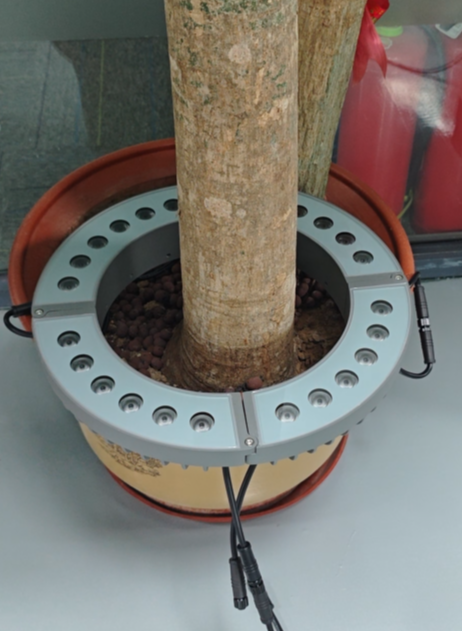
3. Why Choose Outdoor LED Circular Tree Lights for Landscape Lighting?
LED circular tree lights are not a one-size-fits-all solution—they’re designed to meet the unique demands of various environments, from intimate gardens to large-scale urban landscapes. Understanding the different types available can help you select the right fixture to match both your aesthetic vision and practical requirements.
3.1)Residential Tree Ring Lights
Ideal for private gardens, courtyards, and villas, residential-grade ring lights prioritize subtlety, safety, and ease of use. These typically operate on low-voltage systems (12V or 24V), making them safe for homes with children or pets. They often feature warm white LEDs (2700K–3000K) that enhance the natural warmth of wood and foliage, and are sized to suit small to medium trees.
3.2)Commercial-Grade Tree Lights
Built for durability and performance in high-traffic settings like hotels, corporate campuses, and shopping districts, commercial-grade lights feature robust construction—often using corrosion-resistant materials like cast aluminum or stainless steel. They deliver higher lumen output for large or densely canopied trees, and many can be integrated into advanced lighting control systems for centralized management.
3.3)RGB and RGBW Color-Changing Lights
When creativity and flexibility are key, RGB (Red-Green-Blue) and RGBW (RGB + White) ring lights offer dynamic lighting possibilities. Using DMX512 or wireless controls, these fixtures can shift colors to match seasons, events, or brand identities. The addition of a dedicated white LED in RGBW models provides cleaner whites and smoother tonal transitions, making them popular for holiday displays, public art installations, and hospitality venues.
3.4)Solar-Powered Tree Lights
For remote locations, eco-conscious projects, or sites where wiring is impractical, solar-powered ring lights offer energy independence. Modern versions come with efficient monocrystalline solar panels and high-capacity batteries that can sustain illumination throughout the night. While generally less bright than wired equivalents, they’re perfect for creating subtle accents in parks, pathways, or off-grid properties.
3.5)Smart and Connected Lighting Systems
Increasingly popular in both high-end residential and smart city applications, these lights can be controlled via app, voice command, or automated schedules. Features may include dimming, color tuning, motion sensing, and integration with broader smart home or IoT ecosystems. They offer unparalleled convenience for creating lighting scenes or adapting to different times and occasions.
3.6)Custom and Modular Ring Lights
For non-standard tree sizes or highly specialized designs, custom-made and modular ring lights provide a tailored approach. Designers can specify diameters, beam angles, materials, and even special optics to achieve unique effects—such as grazing light for textured bark or wide flood lighting for broad-canopied trees.
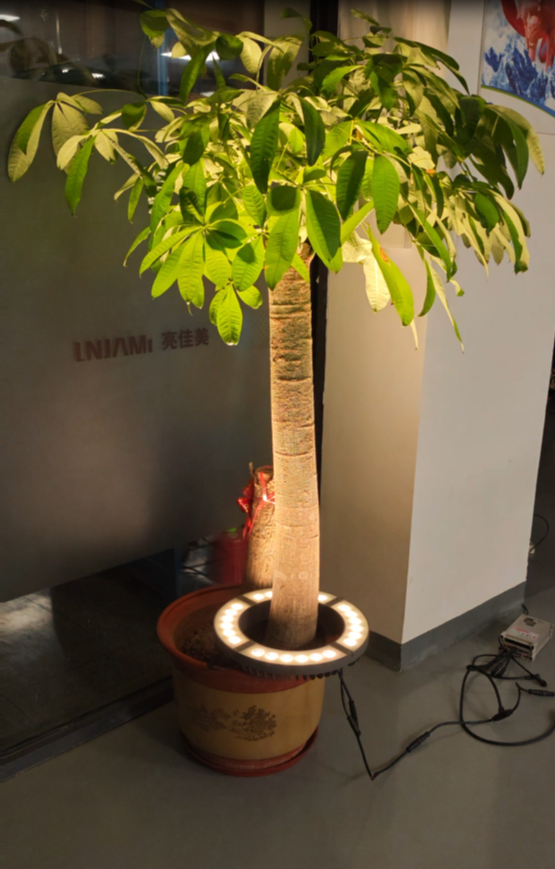
Whether illuminating a delicate Japanese maple in a quiet garden or a towering oak in a city square, there’s a circular tree light designed to meet the need—blending technology, artistry, and nature in perfect harmony.
4. Design Ideas and Applications of LED Tree Ring Lighting
4.1)Residential Gardens and Private Villas
The beauty of an LED circular tree uplight is most evident in residential settings. In gardens or private villas, these lights can turn an ordinary tree into a glowing centerpiece. Imagine a backyard where a tall oak or a graceful palm is softly lit from its base, with warm light traveling up the trunk and spilling into the canopy. This simple yet powerful design technique transforms trees into sculptures, adding depth and atmosphere that make outdoor living areas more welcoming and luxurious.
4.2)Commercial Properties and Hospitality Landscapes
In commercial spaces such as hotels, shopping complexes, and resorts, LED tree ring lights play a strategic role in shaping brand identity and enhancing guest experience. Rows of illuminated trees at entrances create a sense of elegance and exclusivity while guiding visitors toward the main pathways. Guests instinctively follow the illuminated axis, experiencing a heightened sense of arrival that strengthens the architectural and landscape design of the property.
4.3)Public Parks and Municipal Projects
Public parks and urban landscapes also gain tremendous value from the integration of outdoor LED tree lights. When landmark trees are illuminated or pathways are lined with glowing trunks, city planners extend the usability of these spaces after sunset. The lighting improves safety by reducing dark corners, while also creating a sense of comfort for joggers, families, and community gatherings. Over time, illuminated trees become part of a city’s cultural identity, celebrated as natural landmarks within the urban fabric.
4.4)Festivals, Holidays, and Special Events
Festivals and large-scale celebrations provide another dimension for RGB circular tree lights. By programming color-changing effects, designers can set moods that reflect the season or occasion. Golden tones bring elegance to weddings, red and green enhance the Christmas spirit, while vibrant animations add energy to concerts and music festivals. In these moments, illuminated trees transform into dynamic backdrops for storytelling, creating unforgettable experiences for audiences.
4.5)Blending Art with Technology
Ultimately, the design potential of LED circular tree lighting goes far beyond functional illumination. These fixtures allow designers to blend art and technology, turning ordinary trees into living installations that invite people to pause, admire, and interact. Whether used in private residences, commercial landscapes, or public spaces, tree ring lights ensure that trees are not lost in the darkness but celebrated as focal points of the nightscape.
5. Installation and Safety Guide for LED Circular Tree Lights
5.1)Site assessment first
Before any trenching or mounting, survey the tree and surroundings: measure trunk diameter at intended ring height, note root spread, identify underground utilities, check sightlines from approaches and windows, and record soil conditions (drainage, compaction). If the tree is protected or in a conservation area, secure required permits.
5.2)Choose the right mounting method
New plantings: prefer ground-recessed rings or surface-mounted rings set on a small gravel/cement pad. Mature trees: use split/clamshell rings, non-constricting straps, or bracketed mounts that avoid penetrating the bark or compressing the cambium. Always allow a growth gap—select clamps/straps that are adjustable or rings that can be enlarged over time.
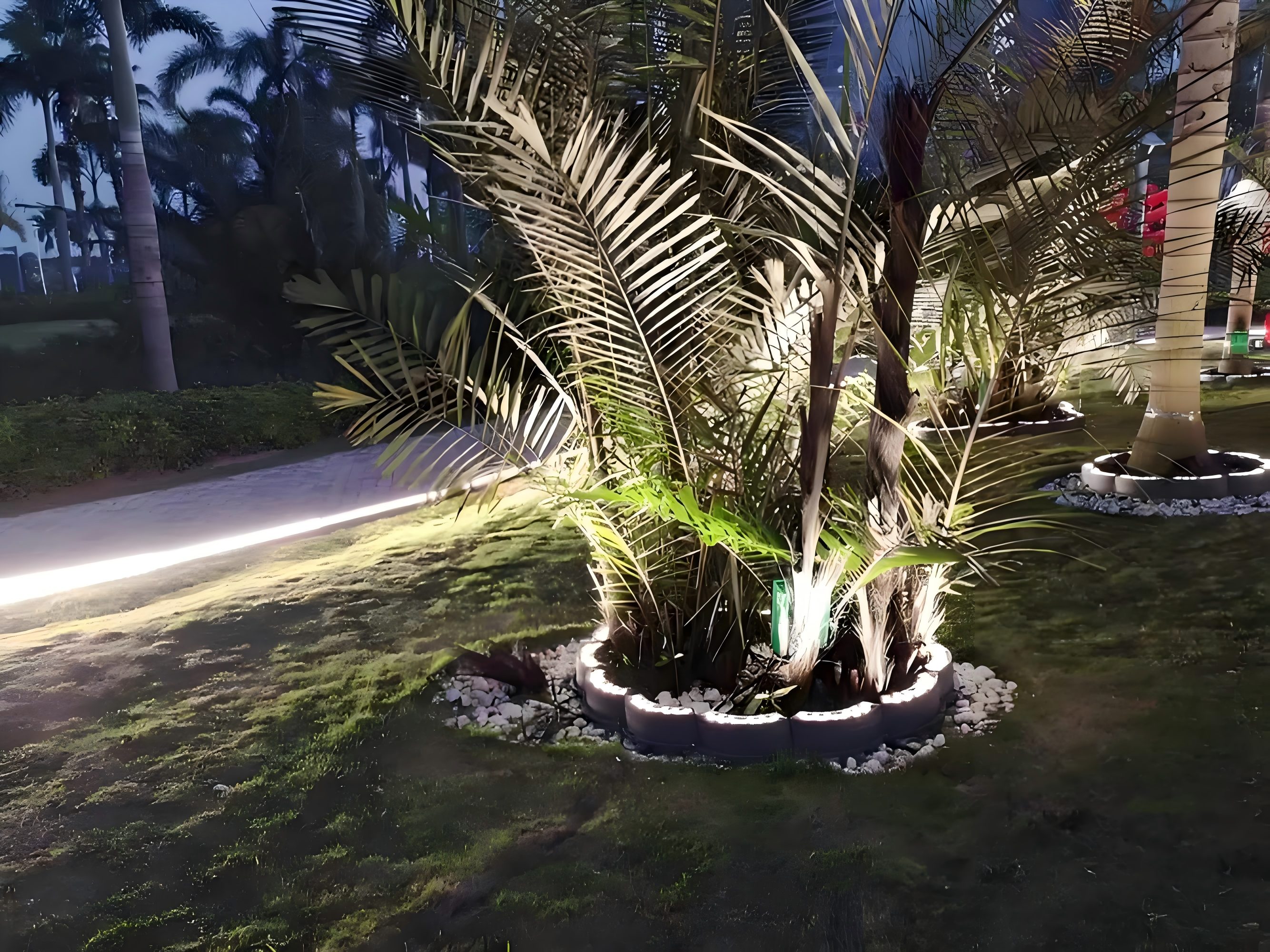
5.3)Follow electrical safety rules
For mains-powered systems have a licensed electrician install the supply. Use RCD/GFCI protection on circuits serving outdoor fixtures. For low-voltage installations, use properly rated transformers/drivers with overcurrent protection. Install surge protection (SPD) upstream of controllers in coastal or lightning-prone areas. Never run flexible lamp cables without conduit where they’re exposed to abrasion or potential damage.
5.4)Weatherproofing and cable management
Use IP-rated glands and connectors (IP65 minimum; IP67 recommended for buried/immersed locations). Bury supply cables to local code depth (or use conduit) and seal entry points into rings with silicone or factory boot seals. Label all underground routes and create an as-built drawing for future maintenance.
5.5)Control and grounding best practices
Integrate DMX512/DALI/IoT controllers in weatherproof enclosures; separate power and control cables to reduce interference. Bond metallic housings to earth ground where required and follow earthing practices for your region. Test for EMC/ground loop issues before commissioning.
5.6)Minimize glare & ecological impact
Aim rings so light is directed upward into trunk/canopy, not horizontally. Prefer warm CCTs (2700–3000K) in ecologically sensitive areas and implement dimming schedules (e.g., reduce to 40–50% late night). Avoid continuous blue-rich lighting near habitats—use spectral tuning or motion-based dimming where wildlife is present.
5.7)Commissioning checklist (do this at night)
Confirm all rings illuminate and match color/brightness presets; walk all pedestrian and vehicular approaches to check for glare or unwanted spill; verify control scenes (event/normal/overnight); measure trunk illuminance at target points and compare to design targets; log driver temperatures and check for overheating. Record final settings and capture photos for the project file.
5.8)Maintenance plan & lifecycle care
Inspect and clean lenses at least once a year (twice in coastal/dusty zones). Check seals, gland tightness, and cable integrity; tighten adjustable straps or re-seat rings as tree growth requires. Replace drivers per manufacturer intervals and keep firmware of smart controllers up to date. Schedule periodic on-site audits (every 1–3 years) to verify performance and ecological compliance.
5.9)Safety and legal notes
Always comply with local electrical and tree-protection regulations. When in doubt about excavation, arboricultural impact, or high-voltage work, hire licensed electricians and certified arborists. Prioritize tree health and people safety over aesthetic aims—good lighting is enduring only when it is safe, maintainable, and respectful of the living element you are illuminating.
6. How to Choose the Right LED Circular Tree Light for Your Project
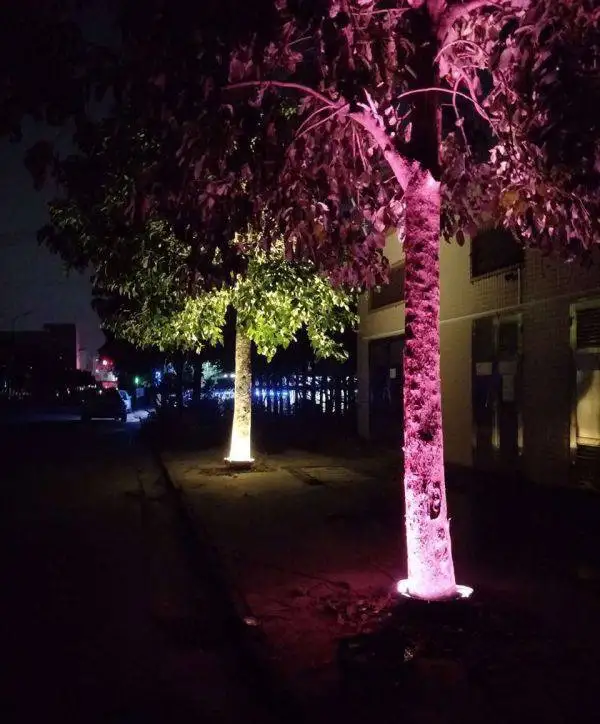
6.1)Brightness and Color Temperature
When choosing an LED circular tree light, brightness and color temperature should always be the first consideration. A warm white tone in the 2700K–3000K range creates intimacy and comfort, making it ideal for private gardens or residential landscapes. In contrast, cooler tones between 4000K and 6000K highlight modernity and sharp details, often preferred in commercial properties such as hotels or shopping centers. For projects that require flexibility, RGB or RGBW lights are invaluable, allowing trees to shift colors for festivals, holidays, or thematic events.
6.2)Durability and Weather Resistance
Since tree ring lights are exposed to the elements year-round, durability cannot be overlooked. Fixtures with an IP65 rating offer protection against general outdoor conditions, while IP67 or higher ensures resilience in heavy rain, dust, or even temporary submersion. Material choice also impacts longevity: powder-coated aluminum is excellent for corrosion resistance, while stainless steel remains the best option in coastal or humid climates. Investing in robust fixtures reduces long-term maintenance and preserves consistent performance.
6.3)Control Systems and Flexibility
Another important factor is the control system. Basic timer settings may suffice for residential use, ensuring that trees glow automatically after sunset. However, larger projects benefit from advanced options such as DMX512 or app-controlled systems, which provide programmable effects, brightness adjustments, and color transitions. These systems give designers and property managers creative freedom while also allowing synchronized effects across multiple trees or zones, turning landscapes into cohesive visual experiences.
6.4)Energy Efficiency and Long-Term Investment
Energy savings are one of the strongest arguments for choosing LED circular tree lights. A well-designed LED fixture can deliver the same illumination as a halogen light while using up to 70% less energy. With lifespans of 30,000–50,000 hours, LEDs minimize replacement cycles, saving both money and labor. Evaluating warranties is equally important, as reliable suppliers often provide extended coverage that reflects the quality of their products. Considering both efficiency and durability ensures not just short-term beauty but also long-term sustainability.
6.5)Achieving Balance Between Aesthetics and Functionality
Ultimately, selecting the right fixture is about finding harmony between design intent and practical needs. The ideal LED circular tree light enhances the natural beauty of the tree while delivering reliable performance under environmental challenges. By balancing light quality, weather resistance, control options, and energy efficiency, any outdoor project—from private gardens to public parks—can benefit from tree ring lighting that is both visually striking and cost-effective.
7. Cost, Energy Efficiency, and ROI of LED Circular Tree Lights
While the initial investment in LED circular tree lighting may give some clients pause, the long-term financial and environmental story is where these systems truly shine. Having designed and tracked dozens of installations over the years, I've seen how the numbers consistently favor LED technology in the long run.
Let's talk real numbers. A typical 15W LED ring light replaces a 50W halogen fixture while delivering comparable—often superior—illumination. For a medium-sized garden with eight trees, this translates to reducing power consumption from 400W to just 120W. At average electricity rates, that's about $150-200 saved annually for just a few hours of nightly operation. One of our commercial clients, a hotel with 50 illuminated trees, saves over $2,800 yearly on electricity compared to their previous metal halide system.
The maintenance savings are equally impressive. LED fixtures typically last 30,000-50,000 hours—that's 7-11 years of nightly use. We recently revisited an installation we completed nine years ago and found 92% of the original lights still performing perfectly. Contrast this with metal halide systems that often require lamp replacements every 6-12 months, plus associated labor costs. For properties with difficult access or numerous trees, these maintenance visits quickly become expensive.
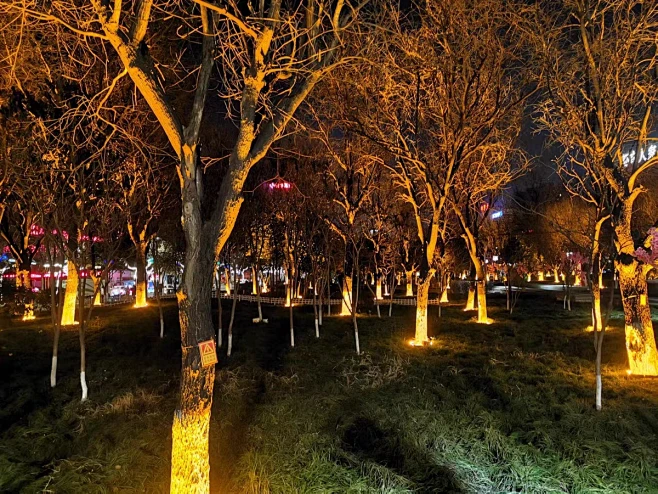
The ROI picture becomes particularly compelling when you consider ancillary benefits. Well-lit trees enhance property security and safety, potentially reducing insurance premiums. For commercial properties, attractive landscaping after dark can extend operating hours and increase customer dwell time.
Here's a quick comparison we often share with clients:
| Cost Factor | Traditional Halogen | LED Circular Light |
|---|---|---|
| Fixture Cost | $80-120 | $150-300 |
| Power Consumption (per fixture) | 50W | 12-15W |
| Lifetime (hours) | 2,000 | 30,000-50,000 |
| Maintenance Cycle | Annual replacement | 5-7 years |
| 5-Year Total Cost* | $400-600 | $180-350 |
Includes purchase price, electricity, and maintenance for one fixture
The intangible returns are equally valuable. We've documented through post-installation surveys that homeowners attribute a 15-25% increase in perceived property value to enhanced landscape lighting. For commercial properties, the nighttime curb appeal becomes a competitive advantage that's difficult to quantify but impossible to ignore.
Perhaps most importantly, today's LED technology offers better light quality than ever before. With CRI (Color Rendering Index) ratings of 80+ for standard fixtures and 90+ for premium models, trees appear more natural and vibrant—the light simply looks better while costing less to operate.
The financial case becomes increasingly compelling when you consider that quality LED fixtures typically come with 5-10 year warranties, protecting your investment long after the payback period is complete. In our experience, most installations achieve full ROI within 18-36 months, then continue delivering savings for years beyond.
Conclusion: Elevate Outdoor Landscapes with LED Circular Tree Lights
An LED circular tree light is more than just a fixture; it is a tool that transforms landscapes into immersive nighttime experiences. From private gardens to public landmarks, these lights highlight the natural beauty of trees while providing efficiency, safety, and long-term reliability.
By choosing the right LED circular tree ring light—considering brightness, durability, control, and energy use—you can create outdoor spaces that are as captivating at night as they are during the day.
Ready to transform your project with LED circular tree lights? Contact us today for product catalogs, design consultations, and tailored solutions for your outdoor lighting needs.





